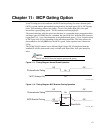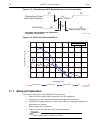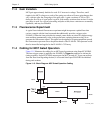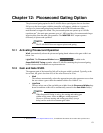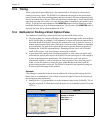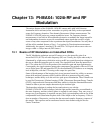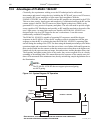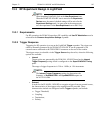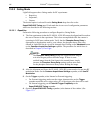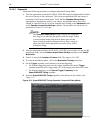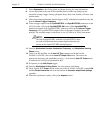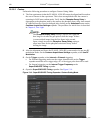
183
Chapter 13: PI-MAX4: 1024i-RF and RF
Modulation
The unique features of the PI-MAX4: 1024i-RF camera and LightField (Princeton
Instruments 64-bit software) allow researchers to quickly and easily create experimental
setups for Frequency domain or Time domain fluorescence lifetime measurements. The
PI-MAX4: 1024i-RF packs two camera capabilities in one. For Frequency domain
measurements, it has built-in RF modulation electronics to modulate the image intensifier
and independent electronics to provide a modulated output signal that can drive a light
source or any other component in the experiment that requires modulation. Not only that, it
still has all the standard features of fast (~ 2 ns) gating for Time domain measurements.
Additionally, the camera’s interline CCD with 1024 x 1024 pixels allows one to take two
images within a <500 ps interval (DIF feature.)
13.1 Basics of RF Modulation on Intensified CCDs
The RF Modulation technique uses an RF source to vary the intensifier gain of an
intensified CCD (ICCD) at a radio frequency (RF) rate. Usually, the object under study is
illuminated by a light source which also varies at an RF rate, equal (homodyne technique) to
the rate at which the intensifier gain is varied. The signal delivered from the intensifier to
the CCD (within the ICCD) is the product of the intensifier gain and input light intensity.
Consequently, the signal contains (among other components) the product of the two RF sine
waves (light source RF and intensifier RF.) So the modulated ICCD behaves as an imaging
lock-in amplifier, with the CCD acting as the output low pass filter.
Some of the advantages of the imaging lock-in are increased sensitivity, ability to measure
phase shifts and time constants which would be difficult to measure using only gating
techniques, and the ability to do this with low peak power illumination. These cameras can
be used for Fluorescence Lifetime Imaging (FLIM,) Fluorescent Resonant Energy Transfer
(FRET,) single molecule fluorescence and other studies in which the illumination must be
limited in order to prevent sample destruction by the incident light.
The homodyne technique is perhaps the best and easiest to use with the
PI-MAX4: 1024i-RF. In this technique, both the light and the intensifier are modulated at
the same frequency, and the (relative) phase is stepped for each image. Thus, once a set of
images at a given frequency is acquired, one may easily (given adequate software for all the
computational work) determine the phase shift of the sample at the set frequency. If this is
done at number of frequencies, one then has the measured complex frequency response of
the sample. This response can be transformed into the time domain using the Inverse
Fourier Transform.



